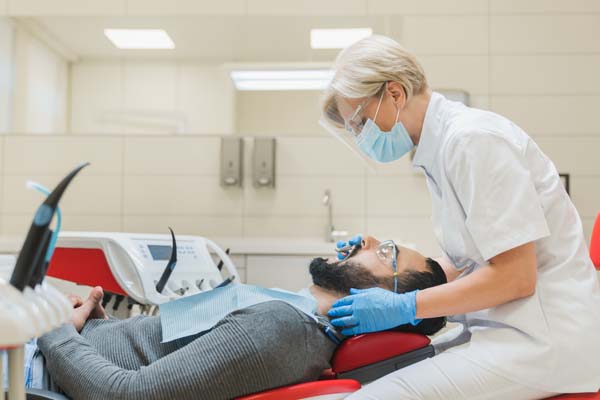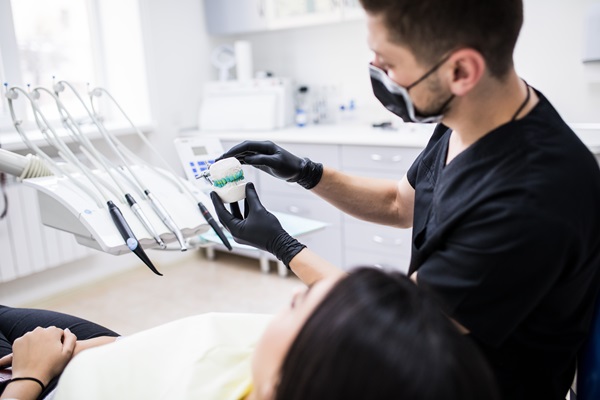How Does Root Canal Treatment Work?

Root canal treatment enables dentists to save infected, damaged, or decayed teeth. The procedure has a reputation as being painful, but this is far from the truth. Root canals were probably painful before the invention of local anesthetics, but now that is no longer the case. Local anesthetics are used during a root canal treatment, so patients do not feel significant pain as the dentist works on their tooth.
The root canal treatment process
Root canal therapy is usually suggested when a tooth’s pulp chamber has been damaged. The pulp chamber houses soft tissues like blood vessels and nerves, and it is sealed off from the rest of the tooth. Injury to a tooth can open this area, leaving these soft tissues susceptible to the bacteria and acids in the mouth. The risk of infection also goes up dramatically when a tooth’s pulp chamber is damaged.
Restoring a tooth with root canal therapy starts with the dentist evaluating the patient to see if it is the correct course of action. A visual examination is often performed, and diagnostics like X-rays might be used to assess what is going on inside a tooth.
Once it has been determined that root canal therapy is the appropriate treatment for the patient, the dentist will start the procedure by injecting the patient with a local anesthetic. This numbs the area being worked on so the patient does not feel pain as the dentist works. They will only feel the force of the dentist pushing and drilling into the tooth.
A dental drill is used to make a hole into the pulp chamber so the dentist can extract the soft tissue there with dental files. Medication might be inserted into the pulp chamber once the area has been thoroughly cleaned.
Depending on the severity of the infection in the tooth, the dentist might opt to reseal the tooth immediately or cover it with a temporary filling so they can insert another round of medication into the tooth in a week.
If the dentist thinks that one round of medication is enough for the tooth, a rubbery material called gutta-percha is used to close the tooth. The tooth can then be rebuilt using composite bonding, or a crown might be placed on it to complete the process.
Recovering after getting a root canal
There is no recovery period after having a root canal. The pain that brought the patient to the clinic is typically gone by the time the procedure is over. After getting a root canal, some patients might experience minor discomfort for the first few days. Over-the-counter medication can be used to address it. Patients are free to return to their regular routine after root canal therapy. Teeth repaired with root canal therapy will not be as strong as they once were, which is why dentists often recommend covering them with crowns to protect them against bite forces.
Save your damaged tooth
Root canal therapy can save your severely damaged or infected tooth. Call or stop by our San Jose clinic to set up an appointment with our dentist.
Request an appointment here: https://mysanjosewillowglendentist.com or call Dental Smiles of Willow Glen at (408) 827-9479 for an appointment in our San Jose office.
Check out what others are saying about our dental services on Yelp: Root Canal Treatment in San Jose, CA.
Recent Posts
Root canal treatment, also known as endodontic therapy, isn’t something most people think about daily, but it’s one of the most common treatments available. If you experience pain in your teeth and are considering treatment, then you may have heard of endodontic therapy, which can save your teeth and make sure you have good oral…
Looking for more information on Root Canal therapy? Root canals are special dental procedures that are necessary in order to save and restore one's oral health. While they do have a reputation for being painful, current dental technology has allowed for an easy, painless procedure. Keep reading to learn when a root canal may be…
When you have a dental emergency, the first thing you should do is call an emergency dentist. An emergency dentist is trained and experienced in handling dental emergencies. Dental emergencies can be debilitating and even life-threatening.Many dentists now offer emergency dental treatments in addition to their regular dental treatments. If there is a dental emergency,…
Regular dental check-ups are a vital part of maintaining and protecting oral health. These visits can prevent a problem before it occurs or help catch a problem early on when it is the most treatable. Dental check-ups aren’t something to dread but are a way to keep your teeth and gums healthy. Schedule an appointment…


